These party-rockin’ tone hunters plug their idiosyncratic axes into gifted Klons, helping them turn Music City into riff city.
Nashville has long been the hub for all things country music but in the last two decades, transplant rockers like Jack White, the Black Keys, Megadeth’s Dave Mustaine, Judas Priest’s Richie Faulkner and others, have all have made the 615 home. Adding to its growth is the organic blossoms generated via the rock block, cultivating names like Paramore, All Them Witches, Bully, Moon Taxi, The Wild Feathers, The Band Camino, and the guitar extraordinaires that make up Diarrhea Planet.
We got caught up with the semi-retired fearsome foursome for their first headlining performance at the Ryman Auditorium ahead of their return to Bonnaroo. We covered why neck humbuckers are useless (but neck dives rule), how the whole band was gifted Klon KTRs, and what each shredator does to stand in and out among their collective guitarmegeddon.Brought to you by D’Addario dBud Earplugs.
73

Diarrhea Planet’s unofficial 7th member is longtime tech and friend Dave Johnson of Scale Model Guitars. (Johnson has done several DIY features for PG, check them out!) Here is his 73rd build based on the Solid Guitar design. Constructed in 2015 it has an alder body, maple neck, and ebony fretboard. The alder was selected to keep the guitar’s weight under five pounds, the neck shape is based on a ’61 Melody Maker, and the fireworks ignite by way of the single Greer Wind humbucker wound by Porter Pickups. He opted for this one because it walks a fine line between a P-90 and PAF for a bouncy, rounder, snappier sound that sits best in DP. The switch is for a “high-octane” mod that bypasses the tone and volume controls and for a direct connection to the output jack for highway-to-the-danger-zone moments. He’s been loyal to D’Addario Medium Balanced Tension strings (.011 –.050) and Dunlop Tortex picks (.88 mm).
Diarrhea Planet Special

This bargain-bin bruiser is a Kramer Striker that cost Smith a mere $349. It has been overhauled by Dave Johnson in a recurring manner that includes Gotoh locking tuners, Graph Tech ResoMax bridge, removed the middle and neck pickups and dropped in a Bare Knuckle Nailbomb, and got a proper fret job and setup.
800 Killer
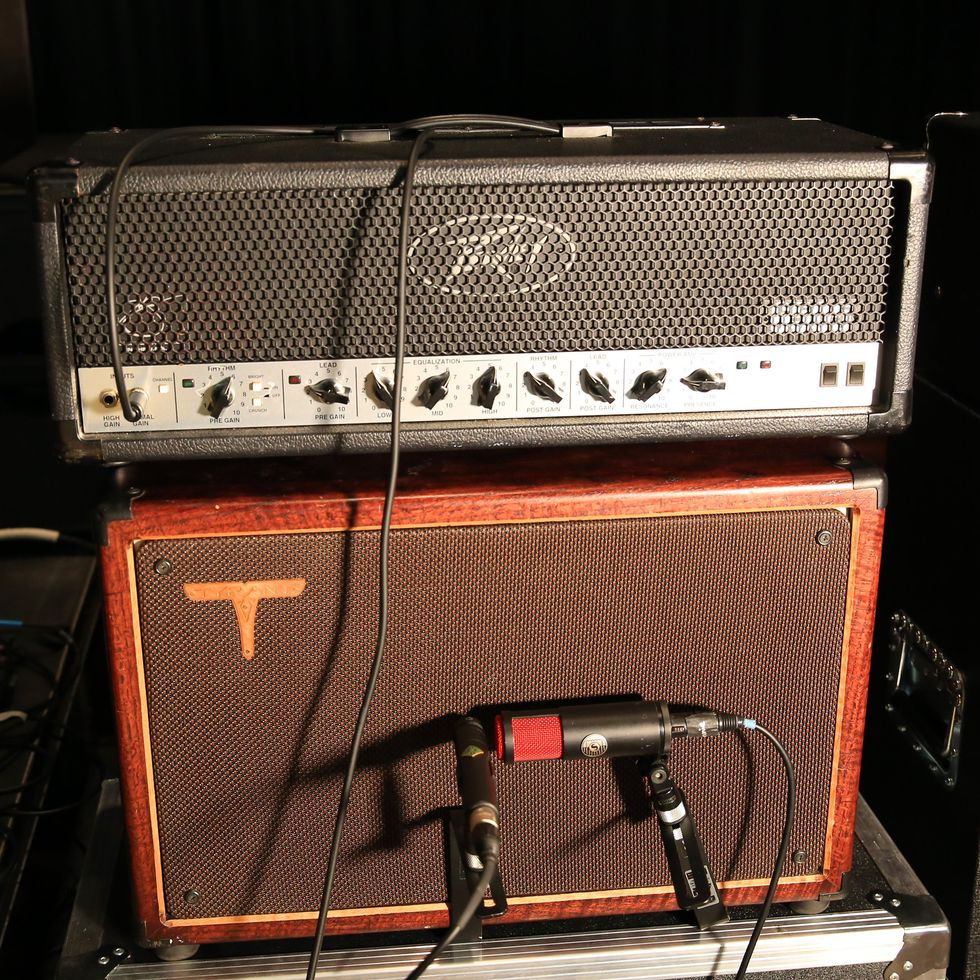
Smith has always been chasing a “bigger, more low-mid focused JCM 800” and this striking steal of a deal he scored fit the bill. The 120-watt Peavey 6505 runs into a Tyrant Tone 1x12 cabinet loaded with a single Electro-Voice Electro-Voice EVM12L Black Label Zakk Wylde speaker.
Jordan Smith’s Pedalboard

Smith’s board holds the staples for DP gigs. It starts with a Spaceman Effects Explorer Phaser, an Electronic Audio Experiments 0xEAE Boost (his favorite pedal on the planet), Boss SD-1 SuperOverdrive, and a Mr. Black Tapex 2. Diarrhea Planet might be the only band to earn KTRs. Back in 2014 or ’15, Klon creator Bill Finnegan and his employee Matt visited DP during a soundcheck near their East Coast-based shop. Finnegan loaned the foursome their own KTR to test out during the run-through. They plugged into them and instantly realized this was the sound they’ve been missing. Finnegan enjoyed the soundcheck so much that he told the band they deserved the magical red boxes and they’ve been on their boards ever since. “I’ll never sell it because we somehow impressed the guy that built one of the most influential pedals ever. It’s an honor and it means so much to me,” admits Smith. Everything rides on a Pedaltrain Classic Jr and is brought to life with a Voodoo Lab Pedal Power 2 Plus.
Dave Does It Again!
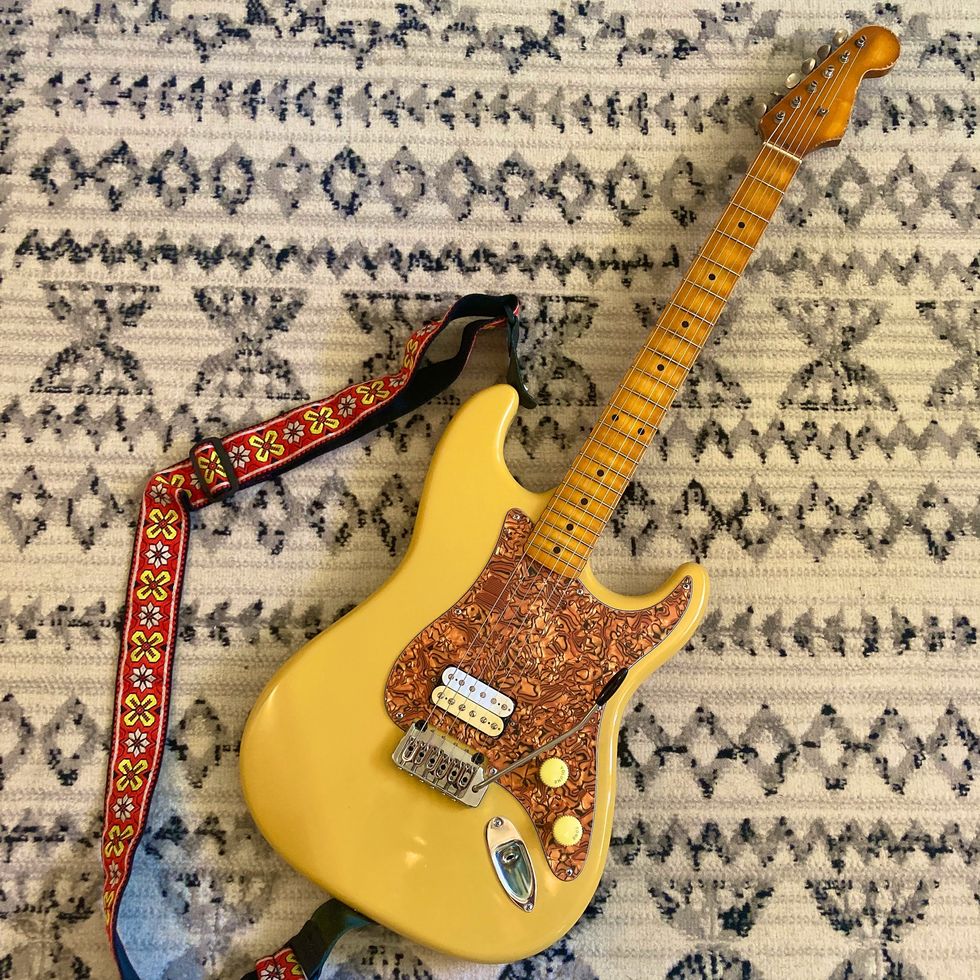
Brent Toler hit the Ryman stage with one guitar—his partscaster baby. Brent sourced all the parts (including painting the body in his parents’ garage) and luthier pal Dave Johnson helped put the pieces together. The single humbucker (with a push-pull pot engaging single-coil mode) was handwound by Alex Avedissian out of Atlanta. It has a HipShot bridge with an upgraded Hipshot Tremsetter Strat tremolo Stabilizer 401000. The roasted maple neck and dazzling pickguard was scooped off eBay. He recently switched from D’Addario strings to local faves Stringjoy.
Steal of a Deal
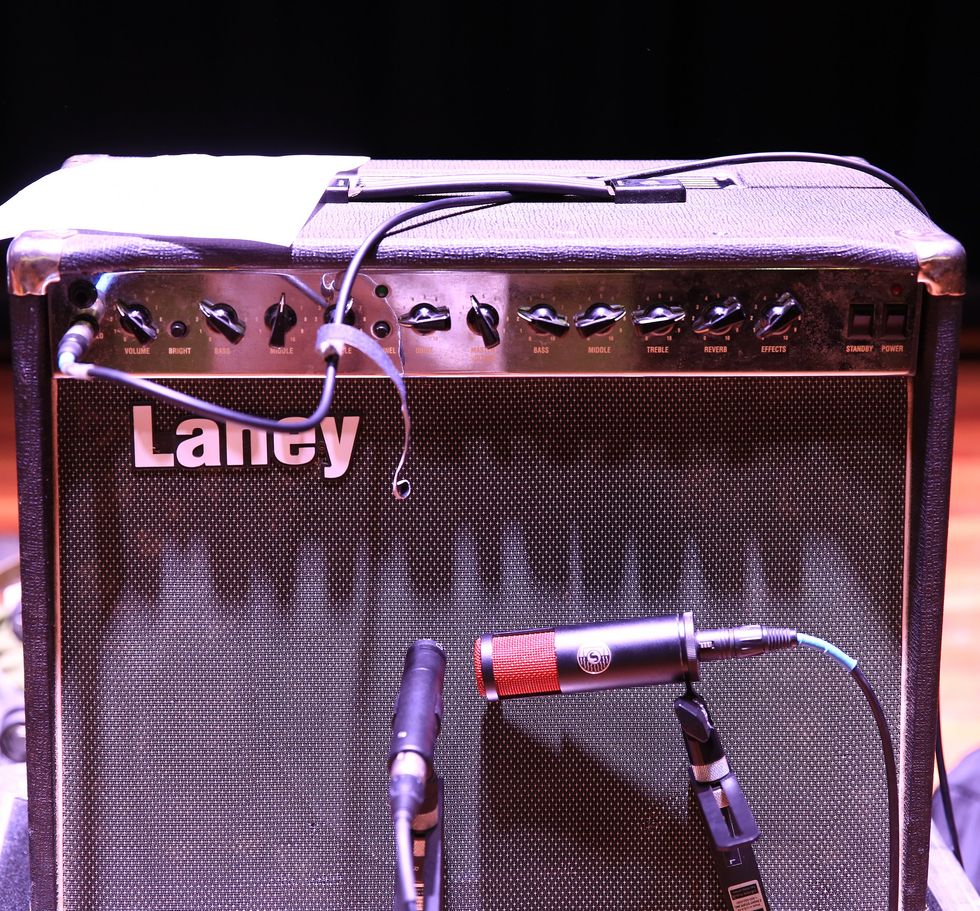
Traveling into town for this pair of shows, Toler packed light with just his partscaster and a pedalboard. He borrowed this Laney LC30 from bassist Mike Boyle who scored the 1x12 tube combo for $200.
Brent Toler’s Pedalboard

Paring down for carry-on limits, Toler returned to Guitar Town with a svelte pedal platform home to five effects and a tuner: a MXR Carbon Copy, a Mooer Yellow Comp, a Bogner Ecstasy Blue, Klon KTR, a MXR Phase 95, and an Electro-Harmonix EHX-2020 Tuner Pedal.
Mother’s Mark

Standing out is a must when you’re battling frequencies with three other guitarists. Emmett Miller takes a left when his brethren take a right. His custom guitar (again built by Scale Model Guitars’ Dave Johnson) is a loving recreation of a ’80s Fender Performer. Miller first got a taste of the futuristic axe when studying at the National Guitar Workshop under Shane Roberts. He posted on Craigslist in the hopes of borrowing a Performer to copy for Dave to build from. He quickly received an anonymous response that included a complete blueprint of the instrument. It has 24 scalloped frets on an ebony fretboard, a Wilkinson/Gotoh VS-100N Tremolo bridge the middle and neck pickups are Hot Stack Plus Strat hum-canceling single-coils, a handwound Avedissian humbucker in the bridge (with a coil-spot mod), and the smaller dip switch adds in the neck pickup with the bridge humbucker. And the best part of the whole thing, the night-sky artwork was painted by Emmett’s mother.
Tone School
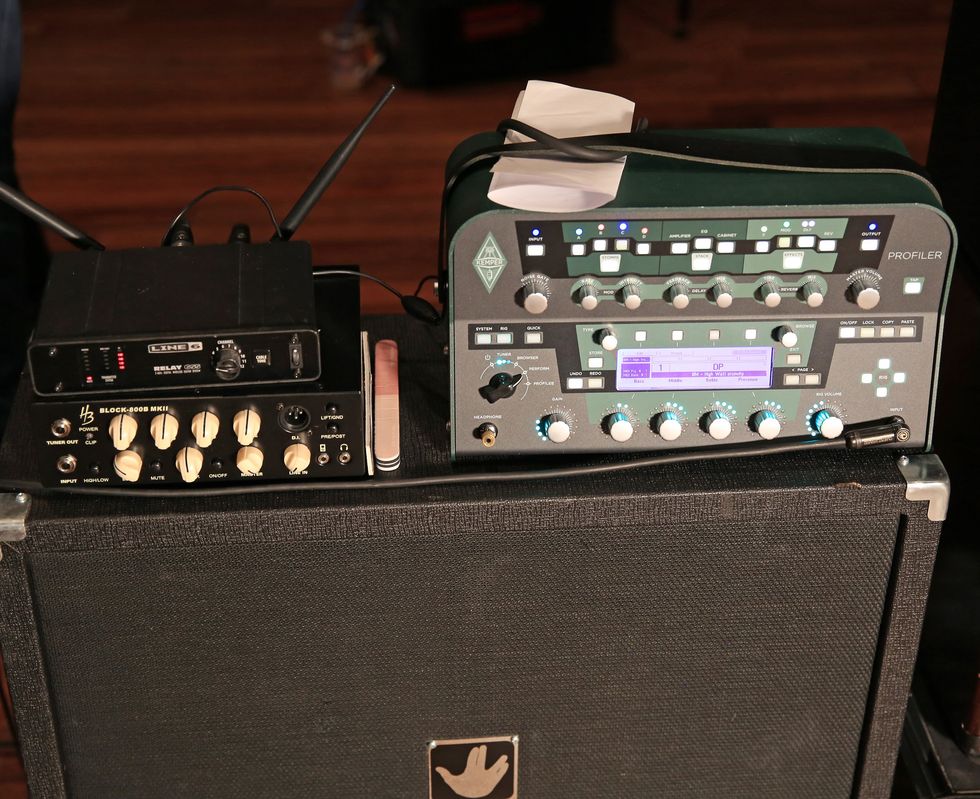
When DP first disbanded in 2018, Miller went off to school to study electrical engineering and digital signal processing, and in doing so, he “had to play through a computer now.” He landed on the Kemper Profiler and hasn’t looked back. He avoids cabling and routes his guitar through a Line 6 Relay G55 Wireless unit.
Emmett Miller’s Pedalboard

Keeping the Kemper on amp-only duties, Miller has a standard pedal playground comprised of a Strymon El Capistan, a Klon KTR, a JHS Sweet Tea V3, Dunlop Cry Baby wah, a Moog EP-3 Expression pedal, a MXR Uni-Vibe, and a TC Electronic PolyTune. Up top you might notice what appears to be a Boss pedal enclosure, but that’s just a goof gift from fellow guitarist Evan Bird.
The Classiest and Nastiest

“I think, in my arms anymore, anything but a Tele feels weird. I do like other guitars, but these are the only ones I can throw around and then still pick back up and play,” concedes DP’s fourth guitarist Evan Bird. This MIM Fender Telecaster Thinline Deluxe was facelifted by Dave Johnson (shocker). It got a refret, improved hardware—including a 3-barrel brass bridge, Gotoh locking tuners, and strap locks—plus a fresh set of Avedissian Night Prowler humbuckers (with a push-pull coil-split mod on the bridge ’bucker). Both his Teles take D’Addario NYXL1052 Light Top/Heavy Bottom strings.
That’s Gold, Jerry, Gold!

Supplementing duties with Thinline is this Squier John 5 signature that’s finished in Frost Gold. It got the Dave Johnson Scale Model treatment and also features Seymour Duncan Pearly Gates with Les Paul-wiring and CTS pots.
Tubes, Schmubes

After toting around a hefty Twin Reverb for years, Bird made the back-saving switch to a Fender Tone Master Twin Reverb that knocks off half the weight. Another issue he was having with the OG tube Twin was blowing up the preamp section by hitting it too hard with pedals. Since making the move to the Tone Master, he’s been flying clear of any meltdowns. And keeping the cables away from his feet is the Sennheiser EW-DX EM 2 Two-Channel wireless unit.
Evan Bird’s Pedalboard
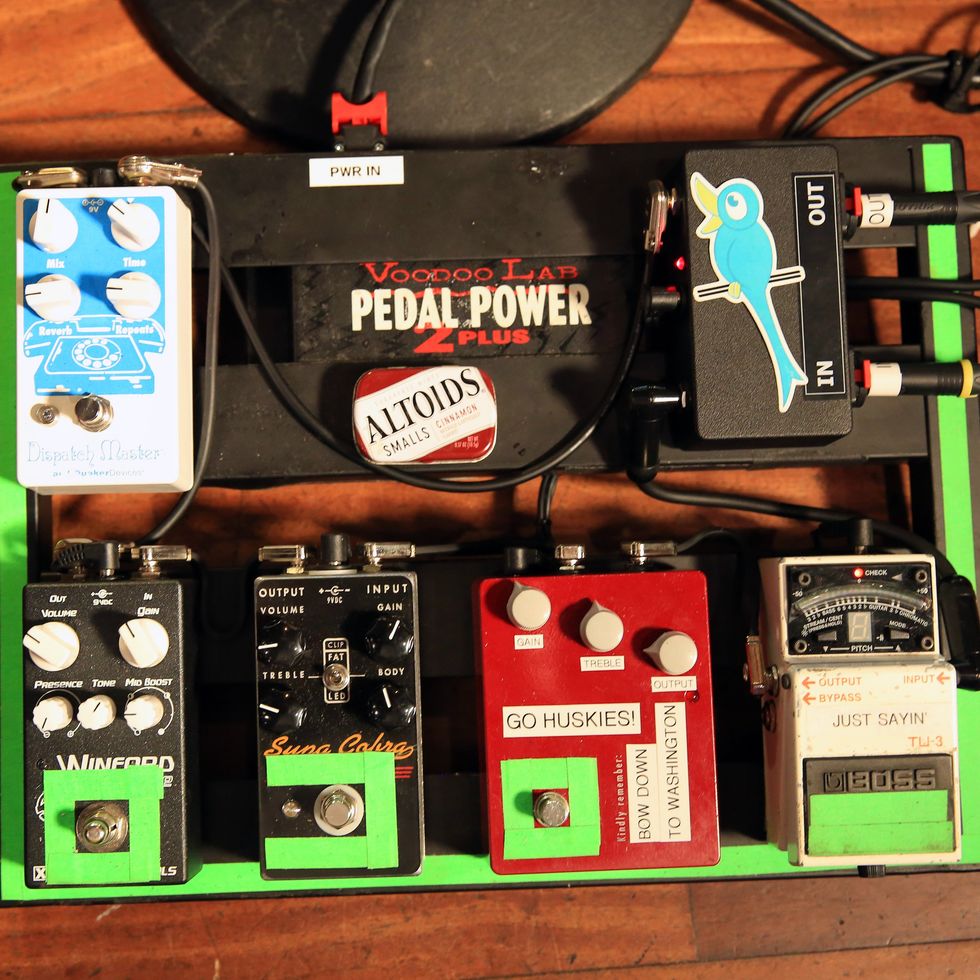
Bird keeps it lean and mean with a 4-stomp pedalboard that includes an EarthQuaker Devices Dispatch Master, XTS Winford Drive, Greer Amps Supa Cobra, and a Klon KTR. Occasional tuning is assisted by the Boss TU-3 and a Voodoo Lab Pedal Power 2 Plus brings the juice.
Shop Diarrhea Planet's Rig

Each module features two channels that house all-analog circuits.
Huntington Park, CA (March 17, 2020) -- Synergy Amps proudly announces cooperation with iconic and legendary hi-gain amp designer Reinhold Bogner. Without a doubt, Reinhold is king in the world of boutique high gain. His creations have been found backing up a wide range of A-list players, such as Alice In Chains’ Jerry Cantrell, Alter Bridge’s Mark Tremonti, Steve Lukather, George Lynch, Eric Johnson and even the late, great Walter Becker.
By partnering with such iconic amplifier designers as Reinhold Bogner, Synergy is able to offer you the most sought-after tones in all-tube designs that are perfect for the direct-recording, lower-stage-volume and compact-guitar-rig demands of today. It’s easy to see why the Synergy preamp module system is taking the industry by storm.
There was no way Synergy wasn’t going to get Reinhold Bogner to re-create his classic metal machine in a Synergy module format. The Bogner Ecstasy and Bogner Überschall amps are true iconic classics and helped in defining modern hi-gain. Both SYNERGY/BOGNER modules have two individual channels based on the DNA of the original circuits, designed to sound and feel like the legendary amps they are named after. SYNERGY modules are all analog circuits and come with loads of switching options for a wide tonal range.
BOGNER ECSTASY
Reinhold Bogner is a king in the world of boutique high-gain. You can find his amps backing up a wide range of A-list players, such as Alice In Chains’ Jerry Cantrell, Alter Bridge’s Mark Tremonti, Steve Lukather, George Lynch, Eric Johnson and even the late, great Walter Becker. Much of Bogner’s appeal comes from his legendary Ecstasy 100-watt head.
The Ecstasy is so popular that players demanded Synergy work with Reinhold to distill it down into this preamp module which is two years in the making. The Blue channel - based on the Ecstasy’s rock ‘n’ roll-approved second channel - offers shades of gain that, when combined with two, 3-position Pre-EQ and Schizo switches, cover everything from blues to hard rock. Switch over to the Red channel, and the same control layout brings in layer after layer of harmonically rich gain, perfect for wide-open leads and metal. With the Synergy Ecstasy module you can now have all of the harmonically rich overtones, searing high gain, plexi-style punch and note definition of the original amp at a fraction of the cost.
Bogner Ecstasy Preamp Module Features:
- Built in U.S.A.
- All-tube preamp module custom designed by Reinhold Bogner and the Synergy designers
- Two channels offer switching between Overdrive and Distortion tones
- Ecstasy Blue Channel - Gain, Volume, 3-Band EQ, Pre EQ & Schizo Switches
- Ecstasy Red Channel - Gain, Volume, 3-Band EQ, Pre EQ & Schizo Switches
- 2 x 12AX7 preamp tubes ensure rich harmonic performance
- Easy to install and remove from Synergy preamp docks
- Dual/Single switch allows the module to be used with older Egnater and Randall hardware
- Three-position cathode select switch allows you to configure the input tube bias setting for optimum input gain and bass response
MAP/MSRP $399.99
BOGNER UBERSCHALL
In the world of high-end, high-gain guitar amplification, the Bogner Überschall is a legend. It’s ability to pile on all-tube distortion while letting every string ring out has made it a go-to amp for an incredible range of players. The Überschall’s - which translates to Super Sonic - responsive, and wall-shaking second channel is where most high-gain fanatics spend their time. Not only does it deliver premium crunch, but it’s extended low-end capabilities make it a perfect choice for players of extended-range and drop-tuned guitars like you could hear it with Korn, Tool, Slipknot and Rammstein to name a few.
By slipping the Synergy Überschall preamp module into your Synergy rig, you’ll unleash the same aggressive tones and impeccable response as the original amplifier. Reinhold even took it a step further with the addition of Pre-EQ, Boost, and Cut mini toggles to further shape your ideal tones.
Bogner Überschall Preamp Module Features:
- Built in U.S.A.
- All-tube preamp module custom designed by Reinhold Bogner and the Synergy designers
- Two channels offer switching between Overdrive and Distortion tones
- Blue Channel Überschall Twin Jet - Gain, Volume, 3-Band EQ, Pre EQ & Cut Switches
- Red Channel Überschall Super High Gain • Gain, Volume, 3-Band EQ, Pre EQ & Boost Switches
- 2 x 12AX7 preamp tubes ensure rich harmonic performance
- Easy to install and remove from Synergy preamp docks
- Dual/Single switch allows the module to be used with older Egnater and Randall hardware
- Three-position cathode select switch allows you to configure the input tube bias setting for optimum input gain and bass response
MAP/MSRP $399.99
For more information:
Synergy Amps
It’s been 25 years since the downtuned guitar duo helped pioneer a sonic path that changed metal. Here they reveal how dealing with the loss of heroes and friends informed their 13th studio album, The Nothing.
There are big rock bands, and then there are bands that completely change the sonic landscape. Korn is definitely one of the latter. The moment this Bakersfield 5-piece’s first single, “Blind” hit the airwaves in the mid ’90s, grunge died, hip-hop was adopted by the heavy rock crowd, and Metallica was no longer the metal band to beat. From that point on, metal had to be down-tuned, groovy, and exceptionally twisted.
Their impact on the guitar was even more dramatic. The band’s earth-moving use of the Ibanez 7-string guitar brought more notoriety to the design than the instrument’s guitar-hero designer, Steve Vai, ever did. And when they paired these extended range instruments with Mesa/Boogie Triple Rectifiers, a gut-rumbling sound was pounded into the metal-guitar vernacular that has remained a standard to this day.
Korn enjoyed a meteoric rise to fame, but the sound they fearlessly pioneered, now called nu-metal, was soon aped by thousands of me-too bands who watered down its impact and created a tidal wave of backlash. Down-tuned riffing, emotionally frightening vocals, and hip-hop influence were now to be avoided like the plague. However, Korn—guitarist Brian “Head” Welch, guitarist James “Munky” Shaffer, vocalist Jonathan Davis, bassist Reginald “Fieldy” Arvizu, and Ray Luzier on drums (Luzier replaced David Silveria in 2007)—always seemed to be the one band to maintain their loyal fanbase and continue delivering the goods.
That’s thanks in large part to their willingness to experiment with their winning formula. After Brian “Head” Welch temporarily left the band in 2005, they began taking some chances with their music that kept fans scratching their heads. See You on the Other Side (2005) boasted a hefty list of co-writing credits with pop mega-hit writers like Matrix, responsible for such chart-topping artists as Shakira, Avril Lavigne, and Britney Spears. Then came 2011’s ThePath of Totality, which blended in a massive dose of EDM heavyweights, including Skrillex, Noisia, and Excision.
Since then, Head rejoined his brothers in Korn, officially in 2013. And, with his help, they’ve begun steering the massive ship back to their beloved, gut-pummeling, emotion-wrenching sound.
“The first record with me back [Paradigm Shift] was more electronic-based with a little bit of heavy mixed in,” he remembers. “But [Serenity of] Suffering was heavy. And now this one’s even more. It’s been a process of making sure everyone can enjoy making music and enjoy Korn.”
Longing for heavy riffs was only part of what has brought the band roaring back. The last few years have also been filled with personal and professional tragedy, including the death of Davis’ ex-wife and some of their most celebrated peers and heroes in the music industry. Needless to say, they had plenty to write about when they hit the studio, and it all culminated in their most recent offering, The Nothing.
The album opens with Korn’s trademark bagpipes as Davis’ familiar roar mixes with his equally identifiable pain-filled cries. As soon as the album’s first full song, “Cold,” kicks into gear, it’s clear that Korn has returned. But it’s the album’s fifth track, “Idiosyncrasy,” that may be the best example of their current sonic incarnation. From the clicking slap bass and pulverizing metal tones to the “Got the Life”-like disco-drum beat in the chorus, everything that made the band great is on full display. And each of these elements has been given a shot of adrenaline, making them heavier, groovier, and more powerful than they’ve ever been.
Much of that power can be attributed to producer Nick Raskulinecz, who has built an impressive resume helping such iconic bands as Rush, Alice in Chains, and Mastodon maximize the impact of their unique attributes. And he does it while continually pushing the bands for more than even they knew they were capable of.
“He’s listening from a perspective, a vantage point, that really lends to being objective,” James “Munky” Shaffer points out. “He’ll say, ‘Let’s not do that. I feel like I’ve heard that from you guys, and it sounds typical for Korn.’ But we also don’t want people to forget who we really are.”
It’s safe to say The Nothing has achieved on both fronts: new, pulverizing production and plenty of Korn’s iconic character. Fans can always count on Korn to eventually return to their roots. But it’s been a long journey back this time around—one defined by loss, renewed friendships, and sonic discovery. But they’re finally here.
Munky and Head took time with Premier Guitar to reflect on this journey. In their familiar, laid-back, California way, they detail how everything that went into The Nothing still came down to coping with life through 7-strings and Mesa/Boogies.
The Nothing has some of Korn’s heaviest moments in years. What inspired a return to such an aggressive sound?
Head: What helped a lot on this record was Jonathan falling in love with heavy music again. We don’t want to make him do something he didn’t want to do. But he just fell in love with it again.
Then having Nick Raskulinecz onboard, he used to flip burgers and listen to “Here to Stay” at the burger joint. He’s like, “Dude, I know what I want to hear as a fan.” We were all on the same page. That’s how it ended up, this type of record.
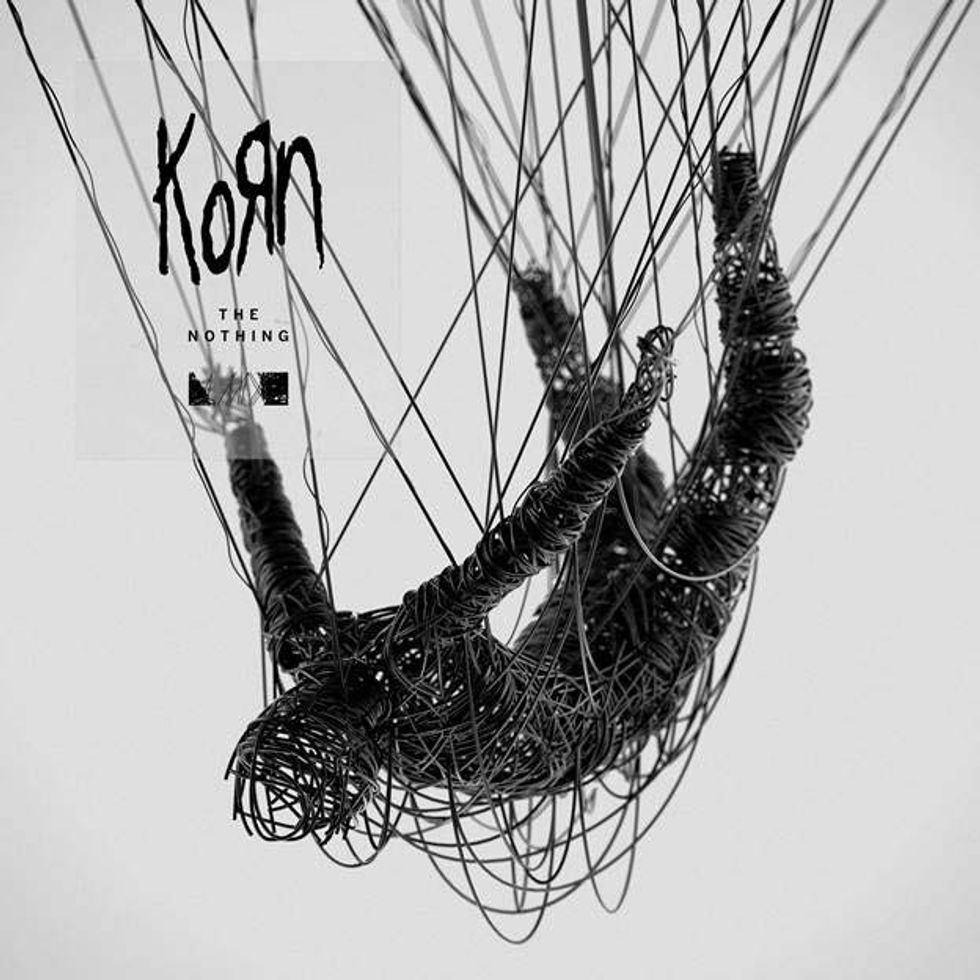
Korn’s 13th studio album was produced by Nick Raskulinecz, who also produced Korn’s 2016 album, The Serenity of Suffering.
Munky: I also think, the tragic loss of some of our heroes recently, like Chester [Bennington], Chris Cornell, and Vinnie Paul. There’s frustration there. That frustration turns to anger, and the only way we know how to release it is through our music. These artists influenced us and influenced us to make it really aggressive. And it tears out your soul when you hear about these tragedies that could’ve been prevented. I think a lot of it came from there.
That also goes for Jonathan’s tragedy. All that pain and anger and not knowing what to do reflects in the music.
The album seems to combine all of your trademark elements, but they’re amplified to new levels. Is it important to keep those “Korn-isms” front and center?
Head: We don’t sit there and go, “We want to sound like this record.” We’re just going day by day. It’s like, “What do you want to hear today, John?” He’ll say, “Think Vulgar Display of Power today.” That’s what sparked that opening riff for “Idiosyncrasy.”
Munky: There’s definitely a balancing act that has to take place. Sometimes we get really comfortable doing what we do. Fieldy is really comfortable playing his bass that way. But sometimes, we have to pull some out and focus on the meat and potatoes of the song. It’s like, “Does it sound enough like Korn? We’ve done that so many times, maybe we don’t need to do that here.” That’s where Nick Raskulinecz really helps.
What is it like working with Nick, and how did he push you to try new things?
Munky: It doesn’t feel like work. It’s like, “Let’s go in and have some fun. Come on, man.” It’s not like clocking in and putting in the hours. We’d play until we’re burned each day. Jonathan has a different story because the lyrics are a whole ’nother animal. But for us, writing the music is, “Does it feel good? Are you happy with it?”
Head: Honestly, he’s another member of the band. And he’s a fan from back in the day. But we know that he’s leading the project with us. He is a producer, and we’re following his lead. But it goes both ways. If he comes in with an idea and we’re not feeling it, we just change it.

